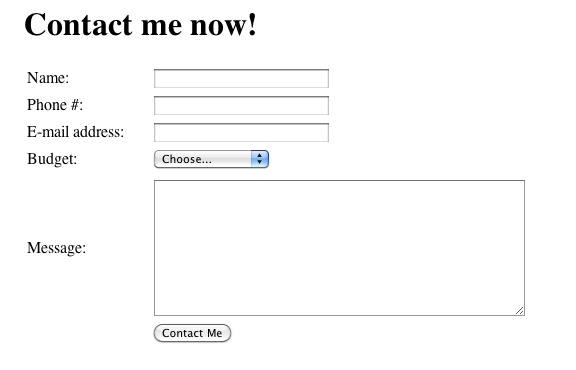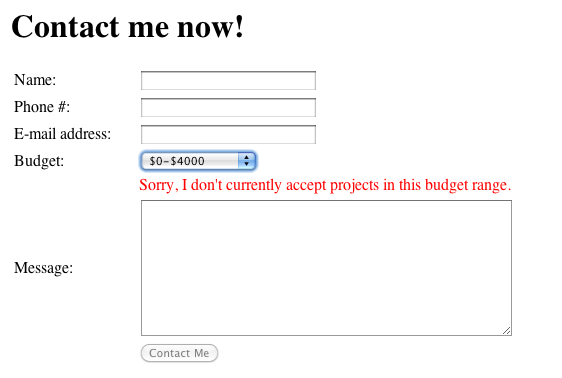Problem
If you’ve read any of my previous posts, you know that revenue sharing is mostly evil. Everyone who has ever held an iPhone has an idea for an app that will (in their mind) make them millions. The number of people who can execute on those ideas, on the other hand, is exceptionally, vanishingly small proportion of developers.
Being one of those developers who knows what he’s doing, I get an awful lot of inquiries from flakey “revenue sharing” people. Up until recently, 90% of my inbox (and at least 75% of my work time) was spent dealing with these people. Let me give you a few humorous examples:
[App name] is a twin stick shooter that requires players to play smart. There are no game [sic] like this out there on any platform therefore we believe that it should sell well as the first of its kind. If you can program the enemies and world to have vibrant or eye catching movment [sic] it will add to the overall fun factor of the game. The game itself is very simple if you are willing to add any elements you see fit then feel free.
As for bosses and level of complexity I first need to know how much time you are willing to put into this project. If you are willing to do more then I will add different enemy types and levels to this.
Here’s some actual artwork I got along with that eloquent description. Keep in mind this artwork had absolutely no explanation or diagram as to what anything was actually supposed to be.

Another actual inquiry:
I am a video game consumer and unemployed wannabe-idea-man. I have this great idea about a game that could work for many platforms, in many different layers of complexity, and it involves cats. Iphone, web-flash, full PC sim…whatever. It will do it all.
I am not very experienced at this video game creation thing, but I am willing to learn. And I am sure that if you love cats, and know games, that once you hear my idea you will want to play the game.
So if you can imagine getting dozens of these in a day, you can see how chasing after nonexistent projects can suck up all your time. Not only was I not coding, I wasn’t even talking to people who would pay me to code.
Solution
I tried a lot of things. The first thing I did was I started replying to all inquiries without even reading them, just to ask what their budget was. A few failed to respond, and thus were filtered out, but the vast majority simply said something cagey like “We’re not sure”. Now I have all the sympathy in the world for a real paying client who doesn’t actually know what the right budget for a project should be, but the number of inquiries like that are less than a sampling error. Substantially more than 95% of those inquiries were from people who were quite sure that they wanted the work done for free. So this plan of attack was not effective.
The next ‘wave of attack’ was to try to quote all these projects so that I could get them to a price “instantly” without wasting any more time. Now for “real inquiries” I produce fairly detailed estimates, which explain to nontechnical clients in some detail what each feature is, and how it affects the others. Anyone in software development knows this is a difficult (some would say impossible!) task, but I think it’s important to explain what parts are hard and what parts are easy to nontechnical folks.
Obviously that approach wasn’t going to scale to dozens of inquiries a day. As much as I’d like to give everybody accurate estimates, there’s only so much time in the day, and I’d like to spend most of it, you know, actually coding. So again, without actually reading the app description at all, I simply fired off an e-mail like this:
Hi <name>. I’ve received your information and a project like this is typically about 6-7k. Let me know if this is agreeable to you and I’ll draw up an agreement for this project.
Having to do this bothered me on two fronts. It bothered me, first, because if I was a real client I wouldn’t like being treated this way. I tend to believe the best in people, and in spite of the data indicating to me that these were all (or nearly all) shady “idea people”, I insisted on believing that a sizeable minority were genuinely confused about their budgets. And it bothered me again because this sort of “estimate” wasn’t anywhere near my standards. Maybe the project was just a “hello world” app, and so the price was high? On the other hand, maybe the project was a triple-A 3D game with multiplayer servers and all, and so it really was a 50k+ project. But I really didn’t have time even to skim the e-mails, so what else was I supposed to do?
Well, what actually happened once I started sending out these “fake estimates” is that 1-2% responded agreeing to the terms, 70% started pushing for a “revenue sharing” deal, and the rest never got back to me. I deleted all the e-mails other than those agreeing to the terms, and things started looking up. I was no longer wasting whole workweeks writing detailed estimates for hundreds of people who had no intention of paying me anything. And those triple-A 3D games? I would assume that if they heard 6k for their app they would follow up, but nobody ever has. So I can pretty safely assume I was worrying about a non-issue.
However, even as my workweek was brightening up, I slowly started realizing how much time I was actually spending copy-pasting my default reply. As my blog posts started to get picked up on the front page of Google for common search strings like “find an iPhone developer”, the number of “shady” inquires I got started massively increasing. At times I was fielding hundreds of replies a day, and every time one came in I was distracted from coding. I considered moving the inquiry e-mail to another account so it wouldn’t interfere with my “real clients”, but this seemed like a poor solution. There has to be a simple, elegant solution to this problem. And there was.
I started by removing all the ways to contact me from my iPhone landing site, drewcrawfordapps.com. I replaced them with this clever contact form:
Looks like your standard, poorly-styled contact form. But here’s the brilliant part. Try selecting a budget range:
If you pick the wrong range, you’ll get an error message and the submit button is greyed out. No more spending time fielding e-mails from people with flakey budgets!
Analysis
While I was reworking the contact form, I decided it was as good a time as any to get some really advanced analytics code installed so I can figure out exactly what people are up to on my landing page. I’ve been tracking the data for over a month now, and I’ve come to some really surprising conclusions.
First and foremost, a lot of people hit that message and bounce. I was hoping that would happen; it’s by design. But it’s nice to get some data to back it up.
Second, I’ve noticed that everybody picks the $0-4k budget first. There has never been a person in hundreds of thousands of hits to that page who have ever started out picking a higher budget. Does. Not. Happen.
Thirdly, when people hit the “low budget” message, if they don’t bounce, they actually rethink their budget. By forcing them to actually think, instead of filling out a box, they actually try a few different options just to see how the numbers look “in black and white”, perhaps to visualize them spending the money. It’s a very solid minority of users, and most of them convert to a real lead.
Fourth, this form has made me a lot of money. Not only am I saving hours every day not fielding silly inquiries, but people are actually much more receptive to my estimates after being “prepped” by this form. It’s a very statistically significant effect, and one that I want to explore a bit more.
Aftermath
Crisis averted! Problem solved! …Right?
Well… it turns out that revenue sharing people can be remarkably persistent. Not most of them. But either there are just so many of them that there are a really persistent few merely by chance, or something about not actually providing much value breeds a certain persistence just to survive. In either case, I still get a few bad apples through the cracks every so often, although these are cleverer than most.
Sometimes they are really clever. For instance, the other day I got an inquiry from people who had actual roles in startups that you’ve heard of. They had an actual idea that might be moderately successful, unlike most. But they wanted me to work for free.
You see, if I want to invest my sweat in something, I will invest in myself. I have plenty of apps of my own that I pursue during my free time. But I would never ask other freelance artists, designers, or other professionals who work on my apps to put their sweat equity at risk for something in which they have no control.
Ideas are never successful the first time. They only become successful after a lot of failure at product/market fit. And unless I have the authority or the control to make them become successful, I might as well just be throwing work away. So unless I’m in a cofounding role, a pure-equity deal makes absolutely no sense. It would be a better use of my time to stock shelves at the grocery store.
So for these new, enhanced breed of clever revenue-sharing guys, I’ve created a third wave of attack: demand either founder-level equity (giving me the authority I need to make the project successful), or demand nonmonetary compensation (i.e. bartering). A lot of these people are talented teams with a good designer, and I am always in need of cheap iOS art, so it seems like the perfect deal on my end. But so far, nobody has taken me up on the offer. They’re fully confident that they’re going to have all this upside to go around after I put in a month of development work, but not confident enough to lend me their designer for a month in compensation. Hmm… I think I’ll pass on that deal.
Want me to build your app / consult for your company / speak at your event? Good news! I'm an iOS developer for hire.
Like this post? Contribute to the coffee fund so I can write more like it.
Comments
Comments are closed.


 Tags
Tags 
Everybody has the ideas. But they just don’t have the skills to implement their idea. I like the idea of a filter to get rid of the time wasters. But I wonder how that would work out if somebody agrees to a 6k budget, but it will require a whole lot more to implement their idea. Renegotiation on your part?
@Maintenance Man
So the contact form isn’t just “pick your price”, it’s just a filter to keep out the worthless folks. I also use it to prioritize my inbox (higher budgets get responded to first; this can make a difference during busy times).
Once I get an inquiry, then I actually quote them. Usually I can eyeball the message to determine if their budget is wildly under and advise accordingly.